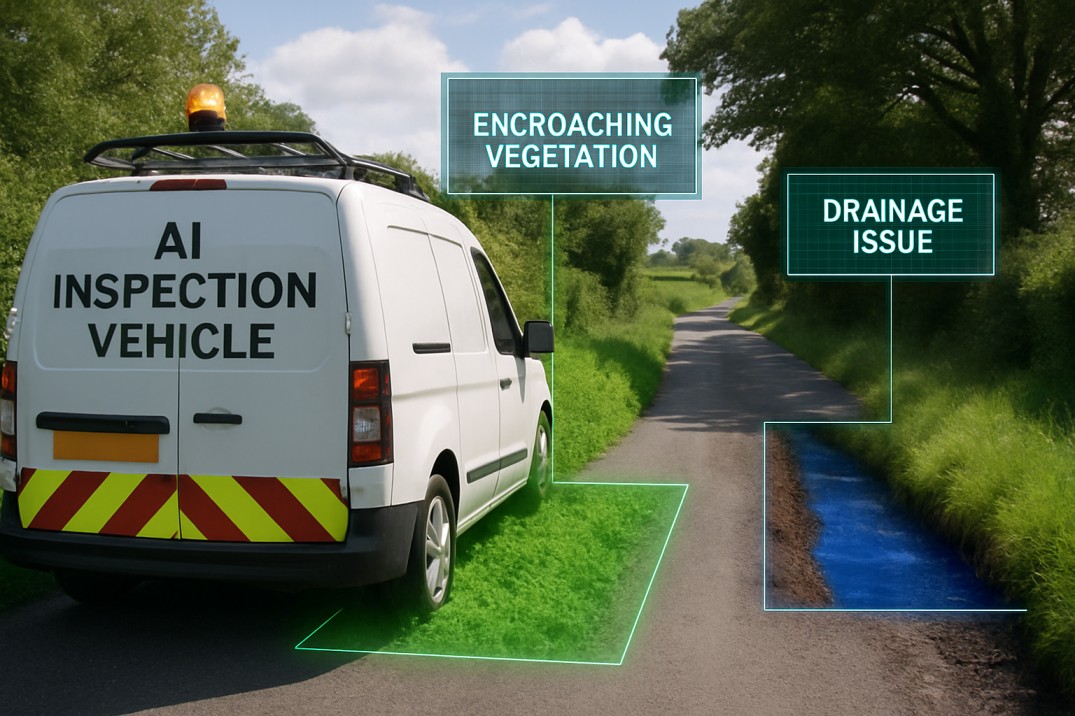Contact Us
RoadVision AI
Private Limited
Office No. 308 & 310, B Block
Ansal Chamber - 1, Bhikaji Cama Place,
Near Engineers India Limited (EIL) Bhawan, New Delhi - 110066
© 2024 | RoadVision AI | All rights reserved
Road asset management in the UK is under increasing pressure due to aging infrastructure, weather extremes, and limited budgets. Among the most neglected yet critical components are verge assets and road drainage systems. These are vital for preventing water damage, preserving pavement life, and ensuring safe driving conditions across the UK's road network.
However, traditional verge inspection UK methods and drainage condition checks are often infrequent, manually intensive, and prone to error. This is where AI road asset management offers a smarter, scalable, and more cost-effective solution.
This article explains how drainage defect detection AI and AI highway monitoring technologies are revolutionising road asset management UK, helping councils and highway authorities identify, assess, and maintain roadside features more efficiently.

In the UK, roadside verges and drainage systems are managed according to the standards set out by National Highways and Well-managed Highway Infrastructure (WMHI) guidelines. According to these documents:
With over 250,000 miles of roads in the UK, consistent roadside asset monitoring is a daunting challenge for councils. The Department for Transport urges local authorities to adopt data-led asset management, which is where AI-powered inspections come in.
Conventional roadside inspections are often carried out by foot patrol or simple visual observation from passing vehicles. These approaches have several limitations:
Drainage structures like gullies, culverts, and ditches may remain blocked for months before being detected, leading to costly pavement failures.
To move toward predictive maintenance, UK road authorities need real-time, scalable monitoring tools—something that AI road inspection systems are now making possible.
With the integration of computer vision, machine learning, and high-resolution camera systems, AI road asset management UK is now capable of:
Platforms like RoadVision AI are at the forefront of this transformation. Their AI inspection tools allow councils to scan thousands of kilometres of roadside infrastructure without stopping traffic or deploying large crews.
Using vehicle-mounted or drone-based inspection tools, these systems continuously collect and analyse images to provide real-time insights into verge and drainage health.
Adopting AI highway monitoring and AI-powered road inventory inspections provides UK councils with a range of benefits:
AI identifies minor drainage and verge issues before they escalate into major problems, helping extend asset life and prevent structural failures.
AI eliminates subjectivity from condition scoring, ensuring all roads are evaluated with a consistent methodology in line with UK road standards.
Thousands of assets can be scanned in a day, reducing the time it takes to complete inspections across large areas.
Reducing reliance on manual crews cuts operational costs and frees up budgets for higher-priority projects.
Data collected through AI inspections supports better planning, budgeting, and business cases for investment, aligned with DfT's Highway Maintenance Efficiency Programme (HMEP).
Explore our services in road inventory inspection and pavement condition surveys to see how these principles apply across your road network.
An intelligent road asset inventory that includes verges, drainage components, and signage is critical for informed decision-making. With RoadVision AI, councils gain access to:
This helps asset managers comply with UKRLG recommendations and justify interventions under constrained budgets.
Recent case studies from local UK authorities show how AI-powered monitoring has reduced unplanned interventions and improved overall service delivery:
These insights led to better allocation of crews, fewer emergency call-outs, and lower lifecycle costs.
The UK is committed to Vision Zero, aiming for zero road deaths by 2040. As outlined in the Road Safety Statement 2023, part of achieving this involves better road condition monitoring and risk management.
AI road asset management UK contributes directly to this vision by:
Learn more about how AI road safety audits complement this process and keep roads safe for all users.
Manual inspections are no longer sufficient for today’s complex and high-demand road networks. AI for drainage and verge condition monitoring in the UK offers councils a faster, smarter, and more scalable approach to roadside asset management.
RoadVision AI is leading innovation in AI in road maintenance, providing a smart, automated solution for managing road networks. It conducts detailed traffic surveys and generates high-quality road data for early detection of issues such as surface cracks and the need for potholes repair. This technology-driven platform brings the power of AI in road planning and monitoring to enhance road safety. Fully compliant with IRC Codes and aligned with UK Highways Agency standards, RoadVision AI supports infrastructure planning that meets the needs of modern UK road networks.
Whether you manage rural B-roads or dense urban corridors, AI road inspection systems provide the accuracy, coverage, and foresight you need to preserve road safety and optimise budgets.
To learn more about how RoadVision AI can support your team, visit our blog or explore our real-world case studies.
Book a demo with us to see how AI can modernise your roadside asset strategy: Contact Us
Q1. What is verge inspection and why is it important in the UK?
Verge inspection involves checking roadside vegetation, slope erosion, and encroachments. It is critical for visibility, drainage, and roadside safety.
Q2. How does AI detect drainage defects on roads?
AI uses cameras and image recognition algorithms to identify issues like blocked gullies, standing water, or collapsed drains during road surveys.
Q3. Is AI-based roadside monitoring compliant with UK regulations?
Yes. AI systems align with National Highways standards and WMHI guidance, ensuring data quality, consistency, and auditability.